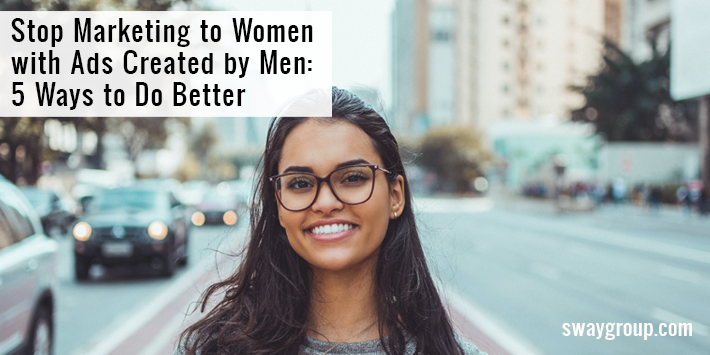Women have long been the primary target of many marketers, not just because they make up roughly half of the entire world’s population, but because of their sheer buying power; it’s believed women drive 70-80% of all consumer purchasing decisions. While plenty of advertisers want to market to women, the objectifying campaigns of years past haven’t improved as much as we’d like to see. Too many ads still rely on outdated stereotypes and impossible beauty standards in a misguided effort to market to women online.

Today’s women are still being failed too frequently by the same industry who’s been failing us for decades. Some brands are still using the “shrink it and pink it” strategy for products, while agency-created traditional ads are routinely missing the mark with misrepresentative gender roles.
What brands need to realize is that it isn’t hard to reach consumers with modern, diverse messaging that takes into account what it’s like to be a woman today. In fact, all you need to do is work with women who know how to talk with other women — and that’s where influencer marketing comes into play.
Influencer marketing has emerged as a far more effective way for brands to connect with consumers. If your business is selling to women in 2020, here are 5 ways to use influencer marketing in a way that drives true action (rather than eye rolls!).
Give Female Influencers Creative Flexibility
Female influencers know what kind of content their audience responds to, so allow promoted content to be shared in their own unique voice and style. Some influencers convey a relatable, everyday vibe, while others offer a more aspirational experience — either way, let your brand messaging shine through within their existing look and feel.
However, think twice about embarking on any kind of campaign based on unrealistic body image claims, even if the influencer seems to occupy that space. Remember the backlash against Kim Kardashian’s “appetite suppressant lollipops”? Women (especially Gen Z and Millennials) are tired of the toxic diet culture, especially amongst influencers.
Go Authentic for Real Impact
The best influencer marketing involves real stories from real people. Any Instagram personality can take a break from their usual content in order to shill a product, but the kind of campaign that really drives action doesn’t feel like a commercial — it becomes an extension of the influencer’s regular commentary.
Female influencers who can talk authentically about the things that matter to them, from their careers to their families to their personal interests, are the best partners for brand sponsorships. It’s all about finding the right context for a great story: brand messaging should be organically woven into the conversation, rather than delivered as a blatant sales pitch.
Never Forget That Content is King Queen
The biggest mistake advertisers keep making is to assume that all women respond to the same messaging. With influencer marketing, you can target so efficiently there’s no excuse for bland “spray and pray” content — you can drill down to the generational and lifestage differences that make up your audience.
Marketing content that taps into the strength, intelligence, and diversity of the female experience is going to outperform overly simplified portrayals, but there can never be a one-size-fits-all answer for what women respond to. Content should be targeted, relevant, and valuable; influencers are already creating this content, and with the right brand/influencer match, businesses can leverage this messaging in a powerfully effective way.
Reach Women Where They’re At
How should brands choose social media platforms when targeting women consumers? It wholly depends on campaign KPIs (key performance indicators), but there are plenty of best-practice tips for doing so. A discovery platform like Pinterest can be ideal for recipes, DIY projects, and craft how-tos, while Instagram’s Stories feature can be an engaging way to show a step-by-step process or fashion board. YouTube is a popular place for beauty tutorials, Facebook can drive deep engagement with paid boosting, TikTok is a hot emerging platform for lighthearted brand content and challenges.
Whatever your business goals may be, there’s a platform strategy for reaching your ideal female audience. Using a varied mix of platforms and influencers often results in the best overall engagement and reach, with paid amplification as a great option for getting even stronger numbers.
Work with the Right People
Ultimately, if you’re marketing to women you should be using women to do so (we’re including all people who identify as women here). It’s honestly as simple as that! If your ad team is a bunch of men sitting around a table brainstorming what women care about, that’s a big red flag. (Hint hint, Peloton.)
Advertisers know that women are largely responsible for purchasing or influencing the purchases of goods for both themselves and the people in their lives (partners, children, aging parents, extended family), but they often forget that in this large and lucrative market there are innumerable differentiating factors. The best way to understand what women’s needs and interests are is to bring women into the process — give them a seat at the table, and listen to what they have to say.
Brands who integrate real women’s stories into their messaging in an authentic way have the best chance of making an impact. Women influencers are the perfect partner for sharing relatable experiences and thoughts while organically weaving in sponsored content.
Tone-deaf messaging not only doesn’t serve the market it’s trying to reach, it can actively breed negative associations. In the end, influencer marketing not only tends to be more cost effective, it has the best chance of returning the success you’re looking for.
Why not give influencer marketing a try instead of paying more for ads that don’t connect? Connect with us today to learn more about how we can help you connect with your target female audience.
This article was originally published on Forbes.
